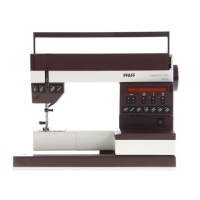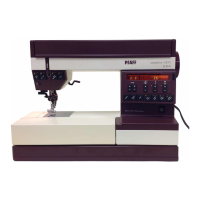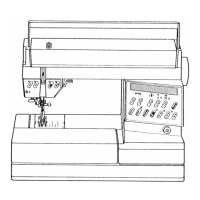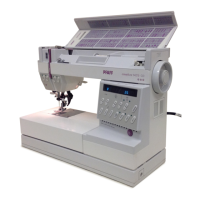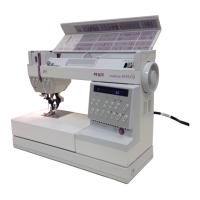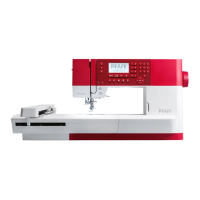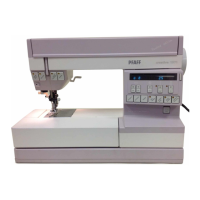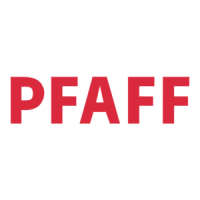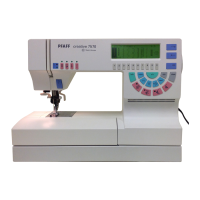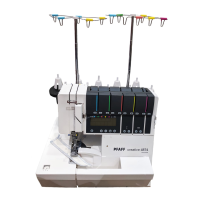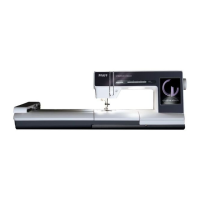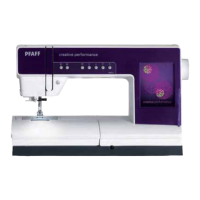Do you have a question about the Pfaff Creative 1467A and is the answer not in the manual?
Critical safety warnings regarding electric shock risks, including unattended operation and water contact.
Safety precautions to prevent burns, fire, or injury, covering toy use, attachments, and ventilation.
Explains the purpose and use of various control keys like needle position and speed.
How to choose and set sewing programs from 00 to 50 to perform tasks.
Adjusts the width of the stitch pattern from 0 to 6 mm.
Controls stitch length (0-6mm) and pattern length for specific programs.
Instructions for sewing the stem components of the embroidery design.
Instructions for sewing the leaf motifs of the embroidery design.
Instructions for sewing the half-flower components of the embroidery.
Instructions for sewing the flower petals of the embroidery design.
Instructions for the first border's middle and outer elements.
Guide for creating the second ornamental border.
Steps for sewing the center motif of Border 1.
Instructions for adding the side motifs to Border 1.
Guide for sewing the centre dots in Border 1.
Explains using twin needles for decorative patterns.
Instructions for creating decorative seams using a twin needle.
Instructions for creating turned-in hem edges using hemstitching.
Guide for applying hemstitching using a wing needle.
Using a wing needle for decorative edge finishes on light fabrics.
Instructions for sewing cording using the cording tongue attachment.
Instructions for the initial stage of appliqué work.
Steps for completing appliqué work, including edge finishing.
Details on storing up to 50 programs and memory limitations.
Steps to access and manage the MEM-memory for program storage.
Modifying pattern length while maintaining stitch density.
Sewing patterns in a mirrored orientation.
General advice for achieving good results with stitches.
Method for neatly top-stitching corners on collars.
Using material support for uniform feeding on thick seams.
Joining and finishing seams simultaneously using overlock stitches.
Techniques for finishing necklines on knit garments.
Details on different needle types and their applications.
Specific needles for decorative and zigzag patterns with twin needles.
Needle type for special hemstitching effects.
Common causes and remedies for skipped stitches.
Troubleshooting issues related to needle thread breakage.
Causes and solutions for needles breaking during sewing.
Addressing issues causing uneven seams, like tension problems.
Diagnosing and fixing issues with inconsistent fabric feeding.
Identifying and resolving problems causing the machine to run poorly.
Troubleshooting the electronic bobbin thread monitoring system.
Resolving issues with program entry or machine not following commands.
Basic straight stitch with 13 needle positions for general sewing.
A temporary stitch for holding fabric pieces together.
Strong elastic stitches for high-stress seams.
Stitch used for embroidery, particularly stems.
For invisible hemming and shell-edging.
Invisible hemming for elastic materials.
High-stretch seam suitable for sportswear.
For sewing and serging seams in one operation.
Zigzag stitch with needle set to the right.
For sewing purl seams.
For basic buttonhole sewing.
For buttonholes on outerwear, coats, etc.
Stitches for fancy seams, ornaments, borders, and embroidery.
For cross-stitch embroidery on children's wear, blouses, etc.
For hemstitching table linen, bed linen, blouses, etc.
Programs for monograms, texts, letters, and numerals.
Method for sewing flat seams on leather materials.
Key settings and zipper foot engagement for inserting zippers.
Step-by-step guide for sewing fully concealed zippers.
Details on different needle types and their applications.
Specific needles for decorative and zigzag patterns with twin needles.
Needle type for special hemstitching effects.
Common causes and remedies for skipped stitches.
Troubleshooting issues related to needle thread breakage.
Causes and solutions for needles breaking during sewing.
Addressing issues causing uneven seams, like tension problems.
Diagnosing and fixing issues with inconsistent fabric feeding.
Identifying and resolving problems causing the machine to run poorly.
Troubleshooting the electronic bobbin thread monitoring system.
Resolving issues with program entry or machine not following commands.
| Brand | Pfaff |
|---|---|
| Model | Creative 1467A |
| Category | Sewing Machine |
| Language | English |
